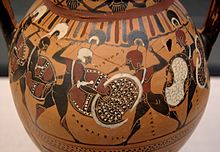75:
31:
59:. Tyrrhenian amphorae were only produced during a short period, about 565 to 550 BC. They are ovoid in shape and bear striking decorations. The handle is usually decorated with a lotus-palmette cross or vegetal tendrils. It always terminates in a red-painted ridge. The vase body is painted with several friezes. The uppermost of these, on the shoulder, is usually especially notable. It often contains
229:
164:
was named after this type of vase. In his 1983 paper '’On the Dating of the
Tyrrhenian Group’’, the British archaeologist Tom Carpenter suggested, on the basis of iconographic and epigraphic considerations, that the vases were produced later than normally assumed, namely between 550 and 530 BC.
71:. Often, the figures are explained by added inscriptions. The other friezes, usually two to three in number, are often decorated with animals. At times, a frieze is replaced with a vegetal band.
133:, by producing features popular in Etruria, such as neck amphorae and colourful decoration. Corinth only produced few neck amphora. Thus, the Athenians apparently deliberately served a
141:
themselves also produced similar vases. The large majority of the nearly 200 Tyrrhenian amphorae now known were found in
Etruria. Early artists to paints such vases include the
330:
385:
261:
113:
299:
335:
284:
411:
215:
74:
125:. It is likely that the Attic vase painters copied Corinthian examples, so as to improve their products’ attractivity on the
30:
186:
233:
254:
39:
294:
53:
122:
247:
35:
150:
79:
154:
161:
372:
304:
345:
142:
103:
406:
289:
211:
129:
markets. Thus, the
Athenian producers entered direct competition with the then market leader,
99:
130:
60:
353:
203:
146:
67:
motifs in Attic vase painting also occur here. Unique motifs include the sacrifice of
400:
358:
309:
134:
83:
56:
17:
380:
91:
138:
228:
87:
68:
270:
126:
95:
64:
166:
109:
50:
165:
Further, he raised the possibility that they were produced outside
73:
29:
239:
243:
169:, perhaps in northern Attica or even outside Attica.
331:
Belly
Amphora by the Andokides Painter (Munich 2301)
371:
344:
323:
277:
121:The animal friezes and use of colour resemble
255:
8:
341:
262:
248:
240:
208:Griechische Vasenmalerei. Eine Einführung
210:, Theiss, Stuttgart 2002, p. 117f.
300:Neck Amphora by Exekias (Berlin F 1720)
178:
7:
336:Two-handled amphora (Boston 63.1515)
102:and Iphis (Herakles’ wife) fights
25:
38:of the Tyrrhenian Group. Munich,
227:
285:Amphora of Hermonax in Würzburg
1:
187:Oxford Journal of Archaeology
40:Staatliche Antikensammlungen
428:
295:Judgement of Paris Amphora
78:Tyrrhenian amphora by the
34:Tyrrhenian amphora by the
106:. Unknown origin, '’circa
412:Ancient Greek pot shapes
123:Corinthian vase painting
49:is a specific shape of
118:
63:scenes, but the first
42:
77:
33:
373:Panathenaic amphorae
236:at Wikimedia Commons
305:Nikosthenic amphora
36:Fallow Deer Painter
27:Ancient Greek vase
18:Tyrrhenian amphorae
386:Euphiletos amphora
346:Melian pithamphora
315:Tyrrhenian amphora
234:Tyrrhenic amphoras
151:Prometheus Painter
143:Castellani Painter
119:
80:Prometheus Painter
47:Tyrrhenian amphora
43:
394:
393:
367:
366:
290:Horsehead Amphora
232:Media related to
190:, 2, pp. 279–293.
155:Kyllenios Painter
149:, later ones the
16:(Redirected from
419:
342:
264:
257:
250:
241:
231:
191:
183:
162:Tyrrhenian Group
21:
427:
426:
422:
421:
420:
418:
417:
416:
397:
396:
395:
390:
363:
340:
319:
273:
268:
224:
200:
195:
194:
184:
180:
175:
114:National Museum
28:
23:
22:
15:
12:
11:
5:
425:
423:
415:
414:
409:
399:
398:
392:
391:
389:
388:
383:
377:
375:
369:
368:
365:
364:
362:
361:
356:
354:Horses Amphora
350:
348:
339:
338:
333:
327:
325:
324:Belly amphorae
321:
320:
318:
317:
312:
307:
302:
297:
292:
287:
281:
279:
275:
274:
271:Greek amphorae
269:
267:
266:
259:
252:
244:
238:
237:
223:
222:External links
220:
219:
218:
204:Thomas Mannack
199:
196:
193:
192:
177:
176:
174:
171:
147:Goltyr Painter
26:
24:
14:
13:
10:
9:
6:
4:
3:
2:
424:
413:
410:
408:
405:
404:
402:
387:
384:
382:
379:
378:
376:
374:
370:
360:
359:Rider Amphora
357:
355:
352:
351:
349:
347:
343:
337:
334:
332:
329:
328:
326:
322:
316:
313:
311:
310:Nolan amphora
308:
306:
303:
301:
298:
296:
293:
291:
288:
286:
283:
282:
280:
278:Neck amphorae
276:
272:
265:
260:
258:
253:
251:
246:
245:
242:
235:
230:
226:
225:
221:
217:
216:3-8062-1743-2
213:
209:
205:
202:
201:
197:
189:
188:
182:
179:
172:
170:
168:
163:
158:
156:
152:
148:
144:
140:
136:
132:
128:
124:
117:
115:
111:
105:
101:
97:
93:
89:
85:
81:
76:
72:
70:
66:
62:
58:
55:
52:
48:
41:
37:
32:
19:
314:
207:
198:Bibliography
185:
181:
159:
135:niche market
120:
107:
84:amazonomachy
61:mythological
57:neck amphora
54:black-figure
46:
44:
381:Burgon vase
401:Categories
173:References
92:Andromache
139:Etruscans
104:Panariste
82:. Front:
407:Amphorae
153:and the
145:and the
127:Etruscan
108:550 BC.
90:combats
88:Herakles
69:Polyxena
131:Corinth
98:fights
96:Telamon
214:
167:Athens
137:. The
110:Athens
65:erotic
100:Anipe
51:Attic
212:ISBN
160:The
45:The
157:.
403::
206::
112::
94:,
86:–
263:e
256:t
249:v
116:.
20:)
Text is available under the Creative Commons Attribution-ShareAlike License. Additional terms may apply.

